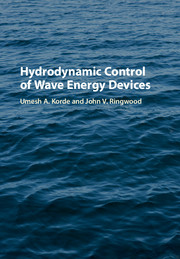Book contents
- Frontmatter
- Contents
- Preface
- Acknowledgments
- Part I Introduction
- Part II The Basics
- 2 Introduction to Control Engineering
- 3 Bodies Oscillating in Air
- 4 Bodies Oscillating in Water
- Part III The Hydrodynamics
- Part IV Velocity Control Using a Hydrodynamic Model
- Part V Control by Optimizing a Performance Index
- Part VI Toward Overall WEC System Hydrodynamic Optimization
- Part VII In Closing
- References
- Index
2 - Introduction to Control Engineering
from Part II - The Basics
Published online by Cambridge University Press: 05 September 2016
- Frontmatter
- Contents
- Preface
- Acknowledgments
- Part I Introduction
- Part II The Basics
- 2 Introduction to Control Engineering
- 3 Bodies Oscillating in Air
- 4 Bodies Oscillating in Water
- Part III The Hydrodynamics
- Part IV Velocity Control Using a Hydrodynamic Model
- Part V Control by Optimizing a Performance Index
- Part VI Toward Overall WEC System Hydrodynamic Optimization
- Part VII In Closing
- References
- Index
Summary
Having considered the challenges and solutions of wave energy conversion systems and the important role of hydrodynamic response control, a brief review may now be in order of the fundamental principles and analysis techniques associated with control systems design. Here we will see the techniques as used in a systems-level analysis of multiple connected mechanisms, energy converters, actuators, and sensors, where a number of forces and responses shape the overall behavior of the combined system. We will also see how one may use measurements of certain response variables in feedback to influence the overall behavior in a known and favorable manner. Altering behavior based on measurements of that behavior is the essential notion of feedback control. This is almost never as straightforward as it sounds, however, and control systems design is generally a nontrivial task, especially for a wave energy converter. Analysis is integral to the design process in control systems, and we will review design techniques that draw on analysis of system behavior under several design scenarios with and without feedback control. Mathematics forms an inseparable part of the analysis and design processes, as all too frequently, systems that combine multiple mechanical, hydraulic, and electric elements behave in ways that challenge intuition. Moreover, control systems design purely via experimental trial and error is often too time consuming and too expensive to be practical, unless guided by strong fundamental understanding. For complex systems, systematic mathematical techniques are an effective way to gain such understanding. Notwithstanding this, the value of qualitative reasoning and design adjustments through experimental testing cannot be overemphasized and has been proven repeatedly through the history of wave energy conversion.
In this chapter, we seek to understand the nature of control systems at a more conceptual level using purely verbal and intuitive arguments. We begin by summarizing the commonly used techniques and terminology in the area of controls. Textbooks such as [48–50] provide excellent explanations and illustrations for most of the basic controls material discussed in this chapter.
Techniques and Terminology
The entire objective of control is to impose a desired behavior or response on a system in the presence of its normal sources of excitation and in spite of any internal or external disturbances.
- Type
- Chapter
- Information
- Hydrodynamic Control of Wave Energy Devices , pp. 33 - 54Publisher: Cambridge University PressPrint publication year: 2016



